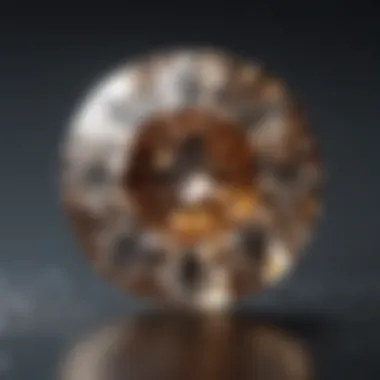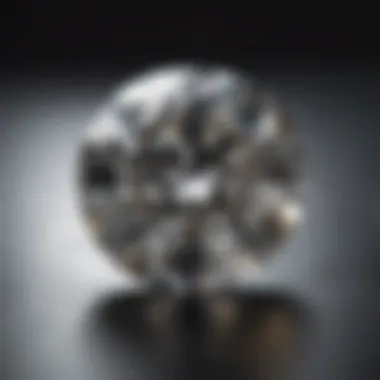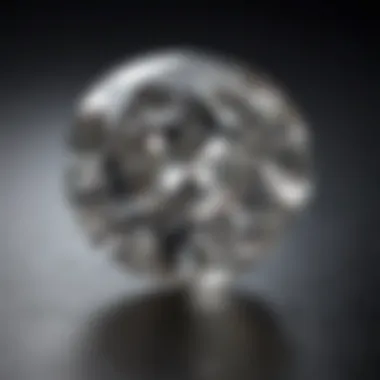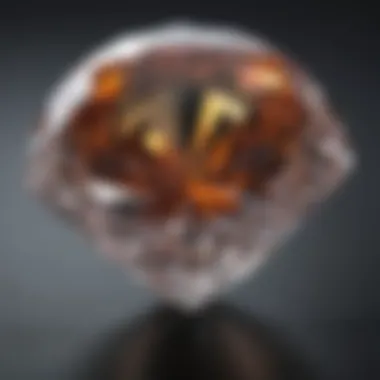Factors Influencing the Cost of a 2 Carat Round Diamond


Intro
The allure of diamonds has fascinated humanity for centuries, and within this precious gemstone, the 2 carat round diamond shines particularly bright. When delving into the cost of these exquisite stones, it’s essential to discern the multifaceted factors that play into their value. This article provides an intricate look into the price dynamics of 2 carat round diamonds, addressing weight, cut, color, and clarity—known as the 4Cs in gemology. We will also explore market trends, purchasing strategies, and the critical role certifications play in valuing these gems, equipping readers to make well-informed choices.
Gemstone Overview
Definition and Characteristics
When we talk about diamonds, we're speaking of carbon in its crystallized form, renowned for its unmatched hardness and brilliance. The term "round diamond" refers to the shape—a classic yet timeless choice that maximizes light return through its precise cut. A 2 carat round diamond typically means it weighs 0.4 grams. While carat weight gives an idea of size, it's crucial to understand that two diamonds of the same weight can vary greatly in price based on their cut and other characteristics.
Classification of Gemstones
Gemstones are commonly classified into two categories: precious and semi-precious. Diamonds, due to their rarity and desirability, fall under the precious category alongside rubies, emeralds, and sapphires. However, within the diamond realm, a further classification exists based on characteristics such as origin and treatment. Natural diamonds are mined directly from the earth, while synthetic diamonds are lab-created, often leading to significant cost differences.
Key Classifications by Origin:
- Natural Diamonds: Mined from the earth, pure consumer favorites.
- Synthetic Diamonds: Created in laboratories, often more affordable.
- Fancy Color Diamonds: Vastly range in hues, often commanding higher prices than traditional colorless diamonds.
When considering a 2 carat diamond, buyers should also be aware of the distinction between "good" and "bad" clarity grades, which can significantly impact value.
In the world of diamonds, clarity refers not only to the absence of internal flaws but essentially to the stone's overall aesthetic impact. A higher clarity grade doesn’t just signal beauty but can also drive the price well above average market value.
Importance of Color and Cut
The color grade of a diamond ranges from D (colorless) to Z (light yellow or brown). The cut, however, is critical—it determines how well the diamond reflects light, often considered the most crucial aspect affecting a diamond's sparkle. A 2 carat diamond with an ideal cut will allow light to perform beautifully, often making it worth more than a bigger stone that’s been poorly cut.
Prologue to Diamond Pricing
The Importance of Carat Weight
Carat weight is one of the first factors that come to mind when discussing diamond pricing. The term "carat" refers to the weight of the diamond, with one carat equivalent to 200 milligrams. As a buyer, you might think a higher carat weight simply means a more impressive stone, and you'd be correct – to an extent. However, it's essential to recognize that weight doesn't exist in isolation. For instance, a 2 carat round diamond is significantly different in both appearance and price than two 1 carat diamonds. What sets a 2 carat diamond apart is its size, which is more about perceived value rather than the raw material itself.
Yet, not all carat weight is created equal. The way a diamond is cut, its proportions, and even the light that passes through it can immensely alter its appearance. So, while you’re focused on that carat weight, it's prudent to look beyond the number. It can be the difference between a diamond that dazzles and one that falls flat.
Overview of the Diamond Market
The diamond market is an ecosystem of its own. It operates under a set of rules and norms that often baffle newcomers. Prices fluctuate based on supply and demand, global economic conditions, and shifting consumer preferences. The introduction of lab-grown diamonds has also thrown a curveball, impacting traditional natural stones' valuations.
Trend analysis reflects a budding interest in ethical sourcing and sustainable options. Buyers are increasingly aware of where their diamonds come from and the implications of sourcing practices.
Collectively, these factors complicate the marketplace, but they also create opportunities for informed buyers. Grasping how the diamond market operates can empower you to make educated choices in your purchases.
"Knowing the market is half the battle when investing in diamonds. The more informed you are, the more confident your decisions will be."
Understanding the layers of diamond pricing is what this article aims to convey. From the weight to broader market trends, each section will guide you through every detail you need to consider before investing in a 2 carat round diamond.
Key Factors Influencing Diamond Prices
Understanding the intricacies behind diamond pricing is crucial for anyone considering purchasing a 2 carat round diamond. Several elements intertwine to determine the final cost of a diamond, each factor holding its weight in the overall valuation. In this section, we'll dissect these elements: carat weight, cut quality, color grading, and clarity ratings. Gaining knowledge about these aspects not only helps in appreciating the beauty of diamonds but also equips buyers to make informed decisions when investing in their precious stones.


Understanding Carat Weight
Carat weight is often the first aspect buyers consider, as it directly correlates with size. A 2 carat diamond is notably larger compared to those under 1 carat, making it a prized choice for engagements and other significant events. However, it's essential to understand that carat weight alone doesn't signify higher value. Two diamonds of identical carat weight can vary immensely in price based on their cut, color, and clarity. Thus, while carat weight plays a pivotal role in pricing, it should be viewed alongside other grading factors.
Evaluating Cut Quality
The beauty of a diamond shines through its cut quality. The cut influences how light interacts with the stone, ultimately affecting its brilliance and shine.
Grading Systems
Various grading systems, like those developed by the Gemological Institute of America (GIA), categorize diamonds based on cut quality. They assess everything from proportions to symmetry and polish. The significant feature of these grading systems is their standardized approach, ensuring buyers can trust the grade assigned to a diamond. Utilizing these grading systems helps maintain transparency in the market, making it advantageous for buyers to navigate the diamond landscape more confidently. Keep in mind that while a well-cut diamond may demand a higher price, the return on investment through brilliance cannot be overstated—consumers often view it as worth every penny.
Impact on Brilliance
Cut quality significantly influences a diamond's brilliance. A diamond cut too shallow or too deep can cause light to escape, diminishing its sparkle. The remarkable aspect of this factor is that even a minor adjustment in cut can enhance the brilliance considerably. Buyers looking for quality should insist on optimal cuts, as this often provides a more dazzling appearance for the same carat weight. The unique feature of cut quality being central to the diamond's overall appeal means it deserves attention alongside carat weight.
Color Grading in Diamonds
Examining the color in diamonds adds another layer to understanding their costs. Diamonds range from colorless to light yellow or brown. The less color a diamond shows, the more valuable it typically is.
Color Scale
The color scale used for diamonds categorizes them from D (colorless) to Z (light yellow). A colorless diamond is rare and highly sought after, making it a luxurious choice for high-end buyers. The benefit of understanding this scale is that it helps consumers discern between diamonds that may appear similar at first glance but can differ greatly in value. Diamonds in the D to H range often attract more buyers and command higher prices because they exhibit more brilliance and saturation compared to those outside this range.
Influence on Value
Color significantly influences the overall value of a diamond. Diamonds that appear colorless generally command higher prices than those that display noticeable hues. The inherent characteristic of color making such a difference means that buyers need to carefully examine each diamond. The unique feature about color grading in diamonds is its subjective nature. Different consumers value color differently, and what might appeal to one could be less desirable for another. Nonetheless, making informed choices based on the color scale can lead to better value for money.
Clarity Ratings and Their Significance
Clarity ratings pertain to the presence of internal or external imperfections, known as inclusions and blemishes. These can impact a diamond's appearance and perceived value.
Types of Inclusions
Inclusions can vary widely, from tiny carbon spots to larger feathers visible under magnification. Understanding these types is crucial; certain inclusions can dramatically affect clarity grades, influencing price significantly. The range of inclusions affects desirability—diamonds with fewer or less visible inclusions typically command a higher price. Buyers looking for clarity should familiarize themselves with different types, as this enhances the ability to gauge quality effectively.
Impact on Pricing
Clarity certainly plays a pivotal role in diamond pricing. A diamond with high clarity holds greater value in the eyes of discerning jewelers and collectors. The key characteristic in this context is that diamonds rated as flawless or vs1 are often remarkably pricier than those in the lower tiers due to their impeccable appearance. While some buyers might overlook clarity in favor of size or color, remember that investing in clarity can significantly lend itself to the diamond's future value—even if an inclusion is not readily visible, it may still dictate market worth.
Additional Factors Impacting Price
Market Demand and Trends
Market demand has a direct impact on diamond prices. A surge in popularity for specific shapes or cuts can cause prices to rise, while lesser-known options might not hold the same value. Furthermore, trends in jewelry can also drive consumers towards particular styles. For example, during engagement seasons or holidays, the demand for diamonds generally spikes, influencing the market in real-time.
As the public's taste changes, certain diamond characteristics may gain or lose allure, shifting prices in either direction. Keeping an eye on these trends can help buyers anticipate potential price hikes, making timing crucial in the purchasing process. In this ever-evolving landscape, staying informed is not just beneficial; it could save you a substantial sum.
The Role of Certification


When investing in a diamond, certification is vital for ensuring the quality and value of your purchase. It provides a professional, unbiased assessment of the gem’s characteristics, which can make or break a deal for buyers.
Reputable Certification Labs
Reputable certification labs, like the Gemological Institute of America (GIA) or the International Gemological Institute (IGI), provide detailed reports that evaluate a diamond’s attributes. These labs follow strict guidelines, meaning their reports are trusted in the industry. Their thorough examinations cover not just the basic four Cs but also additional metrics, ensuring a comprehensive overview of the diamond's quality.
Using a well-known certification lab is beneficial because it enhances buyer confidence. The reputation of the lab carries weight, reassuring potential buyers that they are purchasing an authentic and valuable stone. One unique feature is their advanced technology for grading, which can lead to a more reliable assessment. However, this can also add to the diamond's cost, meaning buyers need to balance their budget with the advantages certification offers.
Importance in Valuation
The importance of certification in valuation cannot be overstated. A diamond with certification from a reputable lab can command a higher price than one without it. This factor contributes to a diamond’s resale value considerably. If you ever decide to sell your diamond, a certification not only boosts your asking price but also attracts potential buyers who seek assurance about the stone they’re considering.
A unique aspect of certified diamonds is the documentation that comes with them, which typically includes a grading report. This detailed data serves to not only inform buyers but also provides grounds for future appraisals. Having this document can become a crucial asset if you find yourself discussing value with appraisers or potential buyers later on.
Origin and Ethical Sourcing
The origin of a diamond also influences its cost. Diamonds sourced from conflict zones may carry a negative connotation, impacting their desirability. On the other hand, ethically sourced or lab-grown alternatives are gaining traction among socially conscious consumers. More buyers today are willing to pay a premium for diamonds that ensure no unethical practices were involved in their mining or sourcing.
This shift in buyer attitudes towards ethical sourcing signifies a larger trend, where consumers are not just looking for beauty and quality but also for peace of mind regarding its origins. Hence, the ethical narrative surrounding a diamond can either elevate its price or diminish it, depending on public perception and market trends.
Price Ranges for Carat Round Diamonds
Determining the price range for a 2 carat round diamond is not just a numbers game; it's a blend of various influencing factors that come together to create a market price. Understanding these price ranges is essential for anyone interested in buying or investing in diamonds. Price points help frame expectations and enable potential buyers to gauge what they can afford, based on their specific requirements and preferences.
The value of diamonds is anything but static. By grasping the typical price ranges, buyers can discern the range of qualities available and make informed choices. Some may aim for luxury, while others want the best value for their budget. Knowing the price classifications can guide you away from overspending or missing out on a great deal.
Typical Price Points
When it comes to 2 carat round diamonds, the price can vary considerably. On average, a buyer should expect to pay between $8,000 and $25,000 for a diamond of this carat weight.
Here are some influences that play into these prices:
- Quality Factors: As covered earlier, cut, color, and clarity ratings heavily influence pricing. A diamond with excellent cut and high clarity will sit at the higher end of the spectrum.
- Market Fluctuations: Like any commodity, supply and demand will shift prices. For instance, during wedding seasons and holidays, prices may be on the increase.
Examples of Price Points
- Entry-Level Diamonds: For a 2 carat round diamond with a lower grade in cut and color, prices could start around $8,000.
- Mid-Range Choices: Diamonds with decent quality can fall in the $12,000 to $18,000 range.
- High-End Selections: Premium diamonds, often characterized by exceptional color and clarity, could be priced from $20,000 and above.
"Understanding these ranges lets buyers assess their own requirements, whether they're after extravagant brilliance or a more modest but still beautiful option."
Variations Based on Quality
Quality is often the differentiating factor that dictates how much one can expect to pay for a 2 carat round diamond. Different aspects contribute to the overall quality, which is effectively reflected in its price:
- Cut Quality: The way a diamond is cut can significantly influence its brilliance. Diamonds cut with high precision reflect light beautifully and thus command a higher price.
- Color Grades: Diamonds graded as D to F are colorless and can vary greatly in cost compared to those of lower color grades (G to Z).
- Clarity Ratings: The clarity of a diamond concerns the visibility of inclusions and blemishes. Higher clarity means fewer imperfections, which generally translates to a steeper price.
Purchasing Considerations
When it comes to buying a 2 carat round diamond, the decisions taken during the purchase process can heavily influence not just the financial investment, but also the overall experience and satisfaction with the gem. Understanding the various purchasing considerations is fundamental for anyone looking to acquire a diamond. This aspect covers the range of choices available, shapes the context for price negotiations, and ultimately affects the joy of ownership. Making informed decisions helps buyers avoid common pitfalls and maximize their value for money.
Where to Buy a Carat Round Diamond


Online vs. Brick-and-Mortar
Choosing between online retailers and physical stores is a significant decision when buying a diamond. Online platforms offer convenience and often wider selection. Shoppers can browse from the comfort of their homes, compare prices effortlessly, and take advantage of online-exclusive deals. However, buying in a store allows for a tactile experience. You can see the diamond firsthand and assess its sparkle and size against your expectations.
Each option has its merits. Online retailers might have lower overhead, thus can offer competitive pricing. But, direct interaction with salespeople in a brick-and-mortar store provides personalized service, helping you to address concerns or questions immediately. Still, the choice depends on personal preference and comfort with online purchasing.
Reputation and Trust
Reputation and trust play a critical role when selecting where to purchase a 2 carat round diamond. Buyers need to consider established and reputable sellers, as they provide assurance of quality and ethical practices. The characteristic of extensive reviews and customer feedback often reflects a seller’s reliability, which can help to build a sense of security around a large financial investment.
Many reputable jewelry brands guarantee authenticity with certification, adding an extra layer of trust worth considering.
However, it's vital for buyers to perform due diligence. When it comes to diamond purchases, one bad experience can leave a bad taste. Checking the seller's history and customer service track record is crucial for making a well-rounded decision.
Negotiating the Price
Negotiating the price of a diamond may seem daunting, yet it can lead to substantial savings. Remember, the initial price presented is often just a starting point. Many sellers expect some back-and-forth discussion. Arming yourself with knowledge about the diamond’s characteristics, as well as market trends, empowers you in negotiations.
Understanding the average pricing for similar stones provides leverage, allowing buyers to request adjustments or inquire about additional inclusions, such as setting or warranties. It’s all about framing the conversation around value, not just cost.
Post-Purchase Considerations
Insurance and Appraisal
After acquiring a diamond, considering insurance is prudent. Insurance covers loss, theft, or accidental damage. Not every policy is the same, which is a key characteristic that buyers should evaluate. An appraisal validates the diamond’s worth, providing a documented value for insurance purposes.
While insurance adds to the post-purchase costs, it offers peace of mind knowing that your significant investment is protected.
Caring for Your Diamond
Caring for your diamond should not be overlooked. Regular cleaning helps maintain its sparkle. A simple solution of mild soap and warm water, along with a soft brush, is often sufficient for at-home cleaning. Remembering to store the diamond in a secure place, away from other jewelry pieces, prevents scratching. This point emphasizes how personal care impacts the longevity of your diamond.
Investing time in proper maintenance highlights the beauty of the gem while safeguarding the quality.
"Understanding the full implications of purchasing a diamond allows buyers to not just choose a stone, but curate an experience that lasts a lifetime."
Navigating the purchasing landscape requires careful thought, but with the right approach, buyers can ensure not just an excellent diamond, but also a gratifying journey to ownership.
Ending
In summing up the exploration of 2 carat round diamonds, it’s clear that understanding their cost is a crucial step for any prospective buyer, whether a first-timer or a seasoned collector. Knowing the intricacies of pricing factors such as carat weight, cut quality, color grading, and clarity ratings allows buyers to make educated decisions that reflect both preference and budget considerations.
Summary of Key Points
To recap the essential takeaways:
- Carat weight significantly influences price but comes with considerations of balance between size and quality.
- Cut quality is vital as it affects the diamond's brilliance and overall appeal. A well-cut diamond radiates more light.
- Color and clarity ratings each play a role in valuation. Even slight differences in these metrics can have a big impact on price.
- Market trends and demand fluctuate, adding another layer of complexity to diamond purchasing.
- The importance of certification cannot be overstated; it reassures buyers about the diamond’s quality and authenticity.
- Lastly, the sourcing of diamonds speaks to ethical considerations that are becoming more relevant in today’s market.
Understanding these points equips buyers with the knowledge to navigate the diamond marketplace effectively. Each factor intertwines to inform not just the price but the overall value of the diamond being considered.
Final Thoughts on Investing in Diamonds
Investing in a 2 carat round diamond can be delightful but demands a blend of heart and savvy know-how. Remember, this isn't just about the stone itself but also about what it symbolizes—commitment, taste, and sometimes family legacy. A diamond is more than a piece of jewelry; it’s an asset that could appreciate over time if chosen wisely.
As you dive into this journey of purchasing, keep in mind to look beyond the surface. Scrutinize the qualities that make a diamond special and hold intrinsic value. Use your findings to shape your choices, and don’t rush the process. When bought judiciously, a beautiful diamond becomes not only a cherished item but also a worthwhile investment.







